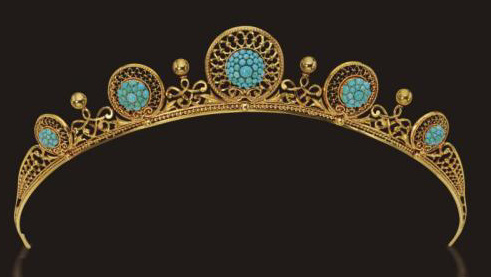Perched on a silver setting, brilliant plique-a-jour enamel rainbow McCaws brighten up this horn comb. c. 1910, unsigned but numbered.
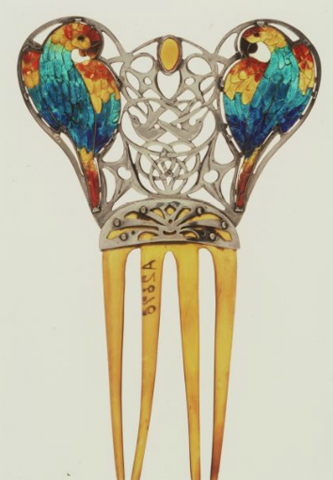
कंघी
For more scholarly research, please examine

Perched on a silver setting, brilliant plique-a-jour enamel rainbow McCaws brighten up this horn comb. c. 1910, unsigned but numbered.

कंघी
For more scholarly research, please examine
Ella married painter Charles W.S. Naper, who became well-known for his English countryside landscapes. They lived and worked in Lamorna, a fishing village in West Cornwall. Ella made this pair of lily-pad combs out of green-tinted horn, and created the dewdrops from moonstones, c. 1906.
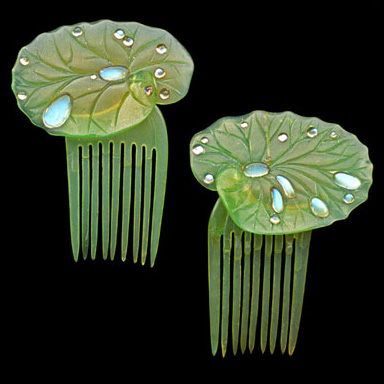
And here is her portrait, painted by her husband.
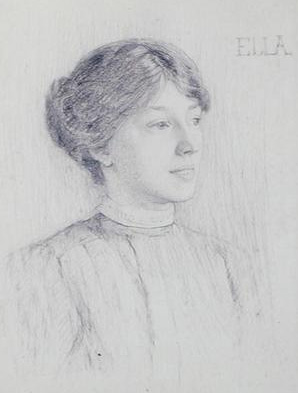
कंघी
For more scholarly research, please examine
This barrette sports mottled blue and green enamel on a silver backing, with two pearls. Britain, c. 1900. It is in the 1200 to 2500 UKP price range at The Tadema Gallery in London.
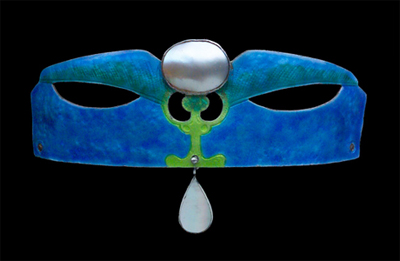
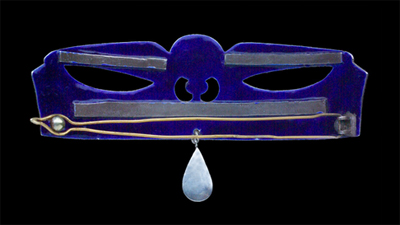
कंघी
For more scholarly research, please examine
My first piece today is actually a British arts and crafts piece by Arthur and Georgie Gaskin, c. 1910. The raised silver-foliage design is bookmarked by pearls. Provenance: Arthur & Georgie Gaskin, City Museum & Art Gallery, Birmingham, 1982, page 87.
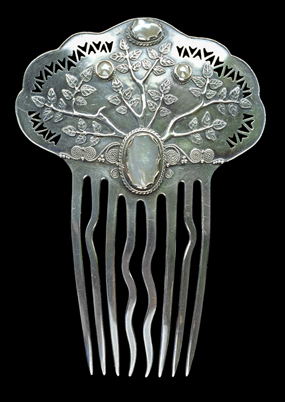
This is a spectacular art nouveau diadem of a Byzantine princess. It is French; made of gold, opal, and diamonds; c.1900. Unmarked, it is attributed to Fouquet or Vever.
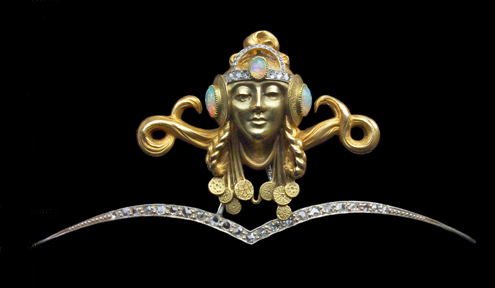
This is an original Lalique drawing of a comb with two Japanese rhinoceros beetles fighting each other (Thank you to member ch for making this correction). The comb was probably to be made out of horn. Maybe the fighting rhinoceros beetles and their feet, performing the engineering function of holding the chains, would be silver, and the jewels in the dangles would be pearls. What a knockout.
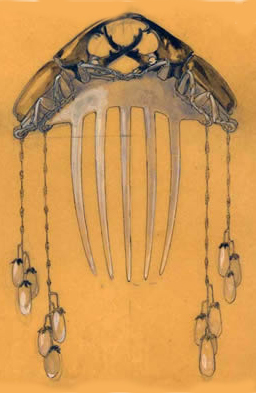
My last piece for this morning is a Lalique pendant, whose centerpiece can easily be taken off and worn in the hair. This piece is so gorgeous, it takes my breath away. The ornament depicts poppies made of glass, enamel, and gold.
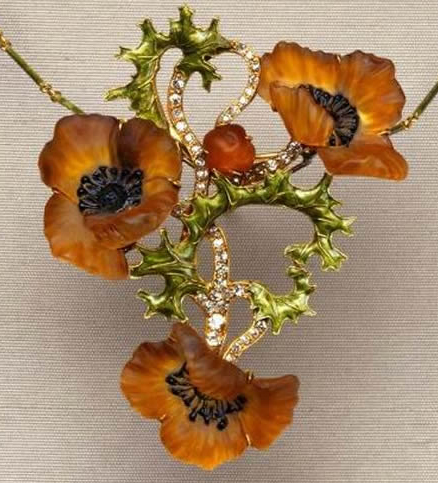
Best known for its British Arts and Crafts and Art Nouveau jewelry, this firm opened in 1880, producing neo-Renaissance pieces. From 1891 – 1916, the imaginative, bright enamel work on their peacock, wing, and insect designs won them Royal patronage. In 1916, the firm closed.
This piece, which is signed, might be part of their earlier work. Hinged to a tortoiseshell comb, the silver tiara is laced with garnets. What I love about it though is the hat on top with its ribbons flowing through silverwork. It sold at Sotheby’s for 1350 UKP.
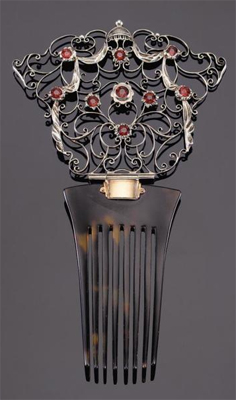
However, when Child & Child’s artistry became revolutionary, one of their most famous pieces was a tiara of two bright blue enamel peacock wings, which sold at the Tadema Gallery in London. I know the price range was over 20,000 UKP, but I cannot imagine the exact, final price.
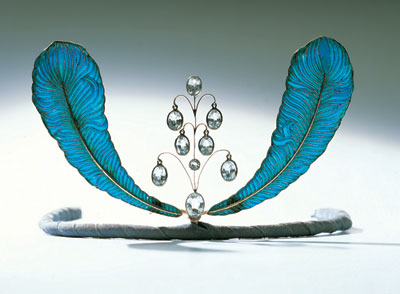
A major figure in the British Arts & Crafts Movement, Joseph Hodel partnered with the Swiss metalworker Louis Weingartner in London. He was also joined the Bromsgrove Guild. Both men supplied the Guild with smaller scale metalwork. In 1908, Hodel left for Liverpool, teaching there until the 1920s. This piece, c. 1906, resides in the Victoria and Albert Museum.
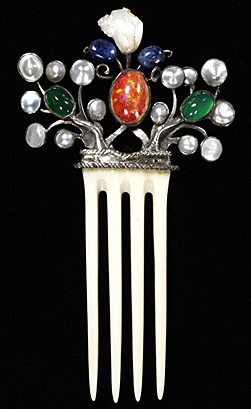
Its maker, Frederick James Partridge (1877-1942) belonged to the arts and crafts organization, Guild of Handicraft, which operated in Birmingham. Its motto was “By Hammer and Hand.”
This hair pin depicts a serpent made of silver plique-à-jour enamel and opal. c. 1900. The silver ornament at its base unscrews, so it can be fitted properly in the hair. This piece has provenance in three books of the jewelry-history literature. The picture shows the front, the back, and the pin at actual size. It is priced in the $10,000+ range at the Tadema Gallery in London.
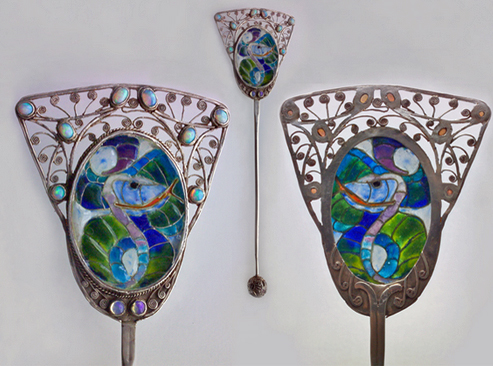
Henry Wilson (1864-1934) made this crystal & chalcedony tiara with wings of gold on either side, and Cupid in the centre. The tiara is c.1908 and resides in the Victoria and Albert Museum. He was a leading figure in the British Arts and Crafts movement and was described as the “arch individualist.” His authored ‘Silver work & Jewellery,’ which was published in 1903.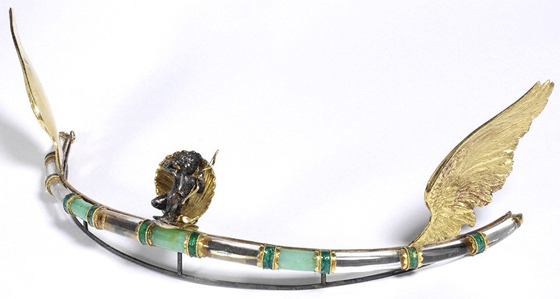
Sothebys is having an auction of magnificent jewels, and as I was looking over the tiaras, I couldn’t help but be struck by the contrast between one made in 1870 and another made in 1970.
The Victorian tiara is made of open work panels of stylised Greek key and foliate scrolls, whereas the 70’s piece is a hinged crescent of elongated panels. What a difference a century makes. However, I have to admit, I totally see a Star Wars Princess in that 1970’s tiara. ;-)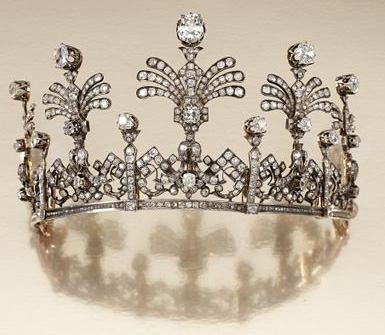

I’m in a Sotheby’s tiara mood I guess. This gold and turquoise tiara was signed by Carlo Giuliano c.1870 and numbered 37. Giuliano was a British jeweler, b.1831, d, 1895, who was a leader in the Revivalist Movement, sensitively interpreting Renaissance jewelry to suit late-19th-Century tastes. The tiara is openwork gold, decorated with five circular clusters of round turquoise cabochons, spaced by entwined scrolls topped by beads. I think it’s gorgeous. Sold for $27,600 on Dec. 6, 2006.